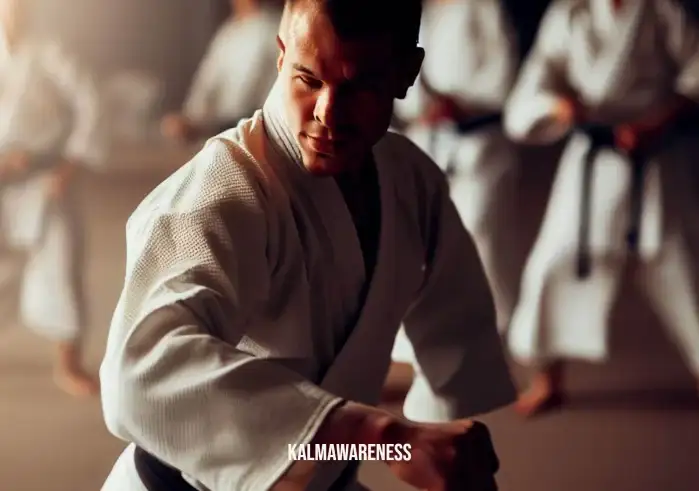Master the 3 Second Shifting Method: Transform Your Mindset, Attain Instant Stress Relief, and Regulate Emotions Swiftly
There’s a popular saying that goes, “Change is the only constant in life.” Yet, in our modern, fast-paced lives, we are often ill-equipped to cope with this constant change. It often results in overwhelming stress and unbalanced emotions. In such scenarios, the 3 second shifting method comes into play, a cornerstone in Rapid Mindfulness Technique, offering a quick fix to regain emotional balance and attain instant stress relief.
What is the 3 Second Shifting Method?
This method is a quick, practical technique that helps you shift your mindset and reset your thoughts in as little as three seconds. Derived from various breathing and meditation practices, the 3 second shifting method aims to help you step back from your current mental state, analyze it, and guide you towards a more balanced and positive mindset.
Consider it akin to a brief meditation on breath where you focus on your breathing, center your thoughts, and shift your mindset to a more positive one. It’s a method that incorporates aspects of mindfulness and emotional awareness meditation.
Benefits of the 3 Second Shifting Method
This method has several potential benefits that you can experience immediately:
- Quick Emotional Regulation: The 3 second shifting method aids in emotional healing by helping you take control of your emotions swiftly. You can regulate your feelings before they spiral out of control.
- Instant Stress Relief: This technique helps you alleviate stress in an instant, much like how a 2-minute meditation can help you feel more calm and composed.
- Improved Mindfulness: Practicing this method can improve your overall mindfulness, similar to the effects of 6 minutes of serenity. You become more aware of your emotions and thoughts, enabling you to make healthier choices.
- Enhanced Emotional Intelligence: Regular practice can lead to enhanced emotional intelligence, making it easier to understand and navigate your feelings, similar to the benefits of anchor meditation.
In essence, the 3 second shifting method is a tool for taming the mind, bringing calmness and tranquility even in tumultuous situations.
Embrace the journey of self-improvement and discover how this method could be the key to unlocking your potential.
“The mind is everything. What you think, you become.” – Buddha
We invite you to continue to the next part of the article, where we will delve deeper into how the 3 second shifting method works, its applications, and how you can incorporate it into your daily life. Let’s explore how this rapid mindfulness technique can become an integral part of your stress management and emotional regulation toolbox.

How to Practice the 3 Second Shifting Method
Much like the diverse shifting methods available for varied circumstances, the application of the 3 second shifting method is fairly straightforward and can be integrated into any situation. Here’s a step-by-step guide to help you master it.
- Awareness: The first step involves becoming aware of your current emotional state. Like the mirror method shifting technique, it starts with recognizing and acknowledging your feelings.
- Pause: Pause for a moment and take a metaphorical step back from your current state, much like the essence of taking a pause.
- Shift: Finally, consciously shift your focus to a more positive thought or emotion. This shift can be something simple like gratitude or happiness. Think of it as a mindful break.
While the above steps seem relatively straightforward, they require practice to become second nature. However, unlike practices that require a specific setting, like a divorce meditation, the 3 second shifting method is adaptable and can be done anywhere, anytime.
Applications of the 3 Second Shifting Method
The beauty of the 3 second shifting method lies in its versatility. It can be used in a multitude of situations for immediate stress relief and emotional regulation.
For instance, when you find yourself overwhelmed with guilt, you can leverage the 3 second shifting technique, much like employing the meditation for guilt. Or if you’re feeling frustrated, instead of resorting to a specific frustration meditation, use the 3 second shifting method to quickly regain control over your emotions.
The table below outlines several situations and how the 3 second shifting method can be applied:
| Situation | Emotion | 3 Second Shift |
|---|---|---|
| Overwhelming work | Stress | Shift to calm |
| Argument with a loved one | Anger | Shift to empathy |
| Grieving a loss | Sadness | Shift to acceptance |
| Feeling of guilt | Guilt | Shift to forgiveness |
| Overthinking | Anxiety | Shift to present |
Remember, the 3 second shifting method is a quick technique to regain emotional balance. For more profound emotional healing, more elaborate methods like the guided meditation for emotional healing can be beneficial.
Unleash the power of your mind and transform your emotional well-being, three seconds at a time.
“You have power over your mind – not outside events. Realize this, and you will find strength.” – Marcus Aurelius
The next chapter awaits, where we will explore some advanced techniques and exercises to enhance your practice of the 3 second shifting method. Learn how to leverage this quick emotional regulation technique to its fullest potential, transforming your life in just a few moments. Let’s continue our journey into the realm of rapid mindfulness.

Enhancing Your Practice of the 3 Second Shifting Method
While the 3 second shifting method is a relatively simple mindfulness technique, it requires regular practice to attain mastery and feel its full benefits. Just like a 2-minute meditation or a 6-minute moment of serenity, it is the consistency of the practice that brings about significant changes.
In the words of the Buddha, “What we think, we become.” This principle stands at the core of the 3 second shifting method, reaffirming the transformative power of our thoughts and emotions.
Regular Practice
As with any skill or technique, the key to mastering the 3 second shifting method lies in regular practice. Regularity fosters familiarity, making the shift almost instinctive over time. It becomes a quick emotional regulation mechanism that you can tap into anytime, anywhere, similar to a brief meditation on breath.
As Bruce Lee wisely noted, “I fear not the man who has practiced 10,000 kicks once, but I fear the man who has practiced one kick 10,000 times.” This quote illuminates the value of mastering one technique, such as the 3 second shifting method, through regular practice.
Pairing with Breathwork
Pairing the 3 second shifting method with breathwork can enhance its effectiveness. Breathwork, like the practice in 3-minute mindful breathing, helps anchor your attention, making the shift in emotion more tangible.
When we breathe in, we can envision inhaling positivity or tranquility, and when breathing out, we visualize expelling the negative emotion. This combines two powerful techniques for a more immersive mindfulness experience. Thich Nhat Hanh, a renowned Buddhist monk and mindfulness practitioner, emphasized the power of the breath, saying, “Feelings come and go like clouds in a windy sky. Conscious breathing is my anchor.”
Broadening Emotional Vocabulary
One of the intriguing aspects of the 3 second shifting method is that it requires us to identify the emotion we are experiencing before we can shift it. Often, we might find ourselves unable to accurately pinpoint our feelings. It’s like trying to describe a color you’ve never seen before. Expanding your emotional vocabulary, much like embracing the 5 senses method shifting, can significantly augment your practice of the 3 second shifting method.
Ralph Waldo Emerson once said, “For every minute you are angry, you lose sixty seconds of happiness.” The 3 second shifting method encapsulates this wisdom, promoting rapid transitions from negative to positive emotions, from anger to happiness, from anxiety to calm.
“The mind is everything. What you think, you become.” – Buddha
The next chapter will delve deeper into the scientific underpinnings of the 3 second shifting method, illustrating its neuroscientific basis and benefits. As we delve into this, we will also touch on how mindfulness and meditation techniques such as the EMDR spiral technique contribute to the same neural shifts. Stay tuned for an enlightening exploration of the science behind the magic.

The Science and Hope Behind the 3 Second Shifting Method
The beauty of the 3 second shifting method lies not just in its simplicity, but also in the profound science behind it. Understanding this foundation offers reassurance, affirming that our efforts in mindfulness are indeed fostering change within us. It is akin to practicing a guided meditation by Tara Brach or embarking on taming the mind, both of which combine understanding and practice for personal growth.
“Science is not only compatible with spirituality; it is a profound source of spirituality.” – Carl Sagan
Neuroplasticity and Mindfulness
The concept of neuroplasticity is central to understanding the science behind the 3 second shifting method. Neuroplasticity refers to our brain’s capacity to change and adapt over time, forming new connections and pathways based on our experiences and behavior.
Mindfulness practices, including the 3 second shifting method, leverage this neuroplasticity to bring about desired shifts in our emotions and mindset. As we regularly practice this method, our brain gradually rewires itself to make the positive shift more automatic and effortless, similar to the habit formation process in the mirror method shifting.
| Technique | Principle | Benefits |
|---|---|---|
| 3 Second Shifting Method | Quick emotional regulation | Increased emotional stability and resilience |
| Guided Meditation | Immersion in a narrative | Heightened self-awareness and relaxation |
| Mirror Method Shifting | Harnessing the power of habit | Reinforcement of positive behaviors and attitudes |
| Mindful Breathing | Anchoring attention to the breath | Enhanced focus and tranquility |
| 5 Senses Method Shifting | Engaging all senses in mindfulness | Comprehensive mindfulness experience |
The Role of the Amygdala
The amygdala, a small almond-shaped structure in our brain, plays a crucial role in emotional regulation. It is our body’s alarm system, priming us for a fight-or-flight response during moments of perceived danger or threat. However, this can also be triggered during less critical stressful situations, leading to heightened emotional responses.
Through practices like the 3 second shifting method and techniques such as EMDR meditation, we can regulate this response, leading to a healthier and more balanced emotional state.
As Carl Sagan once said, “We are all star stuff.” This quote reminds us of our incredible potential for transformation and growth, fueled by the intricate workings of the universe within us.
“We are made of star stuff.” – Carl Sagan
In the next chapter, we will explore various applications of the 3 second shifting method in everyday life scenarios, illustrating how this technique can be a powerful tool in navigating the ebbs and flows of life. We’ll also discuss similar practices like detachment meditation and meditation for guilt, offering a more comprehensive view of how mindfulness can be applied in diverse emotional landscapes. Journey with us as we continue to unearth the transformative power of mindfulness.

The Spectrum of Mindful Practices: Enhancing the 3 Second Shifting Method
The art of mindfulness is both expansive and diverse. It isn’t restricted to a single technique or practice, but instead offers a rich array of methods that serve the varying needs and preferences of each individual. When we weave together different practices with the 3 second shifting method, we discover a more comprehensive approach to mindfulness, enriching our journey towards emotional well-being.
Beyond Stress Management: Emotional Regulation
It’s a common misunderstanding that mindfulness is only about stress relief. While stress management is indeed a vital component, practices such as the 3 second shifting method go much further, offering techniques for emotional awareness and regulation.
“The greatest weapon against stress is our ability to choose one thought over another.” – William James
Imagine a situation that triggers feelings of anger or resentment. Instead of reacting impulsively, we can apply the 3 second shifting method to quickly transition from a reactive to a responsive state. This strategy is similar to practices aimed at coping with specific emotions like the frustration meditation or meditation for contentment.
Mindfulness in Daily Life
The beauty of mindfulness techniques, including the 3 second shifting method, lies in their practicality. These aren’t lofty ideals or abstract concepts, but concrete tools we can use at any moment in our daily lives. Whether you’re in the midst of a challenging work situation or coping with the discomfort of menstrual cramps, these methods provide a refuge, a haven of calm amidst life’s storms.
“In the midst of movement and chaos, keep stillness inside of you.” – Deepak Chopra
When practiced consistently, such methods become part of our default response mechanism. They form a natural buffer against stress and negative emotions, much like the soothing effects of a 5-minute self-care routine.
Additional Tools for Shifting
While the 3 second shifting method is incredibly effective on its own, it can be enriched when combined with other shifting techniques. Practices such as the no sleep method shifting or the 5 senses method shifting offer alternative ways of attaining a quick mindset shift, thus providing a broader toolkit for personal transformation.
“All that we are is the result of what we have thought.” – Buddha
Through these techniques, we’re empowered to navigate our emotional landscape skillfully, wielding the ability to shift our state of mind at will, akin to the process involved in the quickstart approach to launching an art.
As we continue to the final chapter, we will reflect on the broader implications of the 3 second shifting method for overall well-being and personal growth. We will also discuss the role of consistency and practice, comparing it to routines like the 3-minute morning and the 5-minute meditation for sleep. Stay with us as we delve deeper into the transformative power of mindfulness and its potential to catalyze profound change in our lives.

A Journey Towards Well-Being: The 3 Second Shifting Method and Beyond
As we draw to the end of our exploratory journey through the 3 second shifting method and its intricate ties with mindfulness, it’s important to pause, reflect, and realize that our voyage towards self-awareness and emotional well-being is just beginning. The 3 second shifting method is a powerful tool, but it is not a panacea. It forms an integral part of a larger framework of practices and techniques, each with their unique contributions towards promoting holistic well-being.
The Role of Regularity
Mindfulness practices, like the 3 second shifting method, are most effective when they’re an integral part of our daily routine. Just as we maintain our physical health through regular exercise, we can cultivate emotional resilience by consistently practicing mindfulness techniques.
“The secret of your future is hidden in your daily routine.” – Mike Murdock
Consider the 3-minute morning routine, a brief yet powerful mindfulness practice that sets the tone for your day. Coupling this with regular use of the 3 second shifting method throughout the day ensures you are mindfully present, responsive, and emotionally balanced.
Developing Sleep Hygiene
As we move towards building a mindful lifestyle, we also need to pay attention to the quality of our rest. 5-minute meditation for sleep is a short practice designed to help prepare your mind for restful sleep, complementing the 3 second shifting method that keeps your mind steady and calm during the day.
“Sleep is the best meditation.” – Dalai Lama
The Power of Now
Mindfulness, at its core, is about being present in the moment. It’s a way of life, a mindset that we adopt to live more fully and authentically. This principle is beautifully encapsulated in techniques like the mindful break and taking a pause. When we weave these practices with the 3 second shifting method, we create an environment that nurtures emotional stability and clarity of mind.
“The present moment is filled with joy and happiness. If you are attentive, you will see it.” – Thich Nhat Hanh
On this journey, remember that every step, every moment of mindfulness counts. Keep exploring, keep practicing, and above all, remain patient with yourself.
As we conclude our exploration, I invite you to continue delving into the fascinating world of mindfulness. Our blog has a plethora of resources, covering a wide spectrum of practices beyond the 3 second shifting method. Perhaps you could start by trying the 12-minute guided meditation or explore how to detach from negative emotions with the detach meditation.
The journey of self-discovery is an enriching one, filled with insights, growth, and moments of profound realization. As you move ahead, remember that each step is as significant as the destination itself. Here’s to a more mindful, balanced, and joyous life!




![shifting methods without visualization _ Image: [A bright and tidy office space with the team gathered around a large table, engaged in a lively discussion, gesturing confidently at a well-organized plan on the screen.]Image description: Team members gathered around a spacious, well-lit office space, discussing animatedly around a computer screen displaying a meticulously organized shifting strategy; confidence and unity in their approach.](https://kalmawareness.com/wp-content/uploads/2023/09/138_5-300x211.webp)
